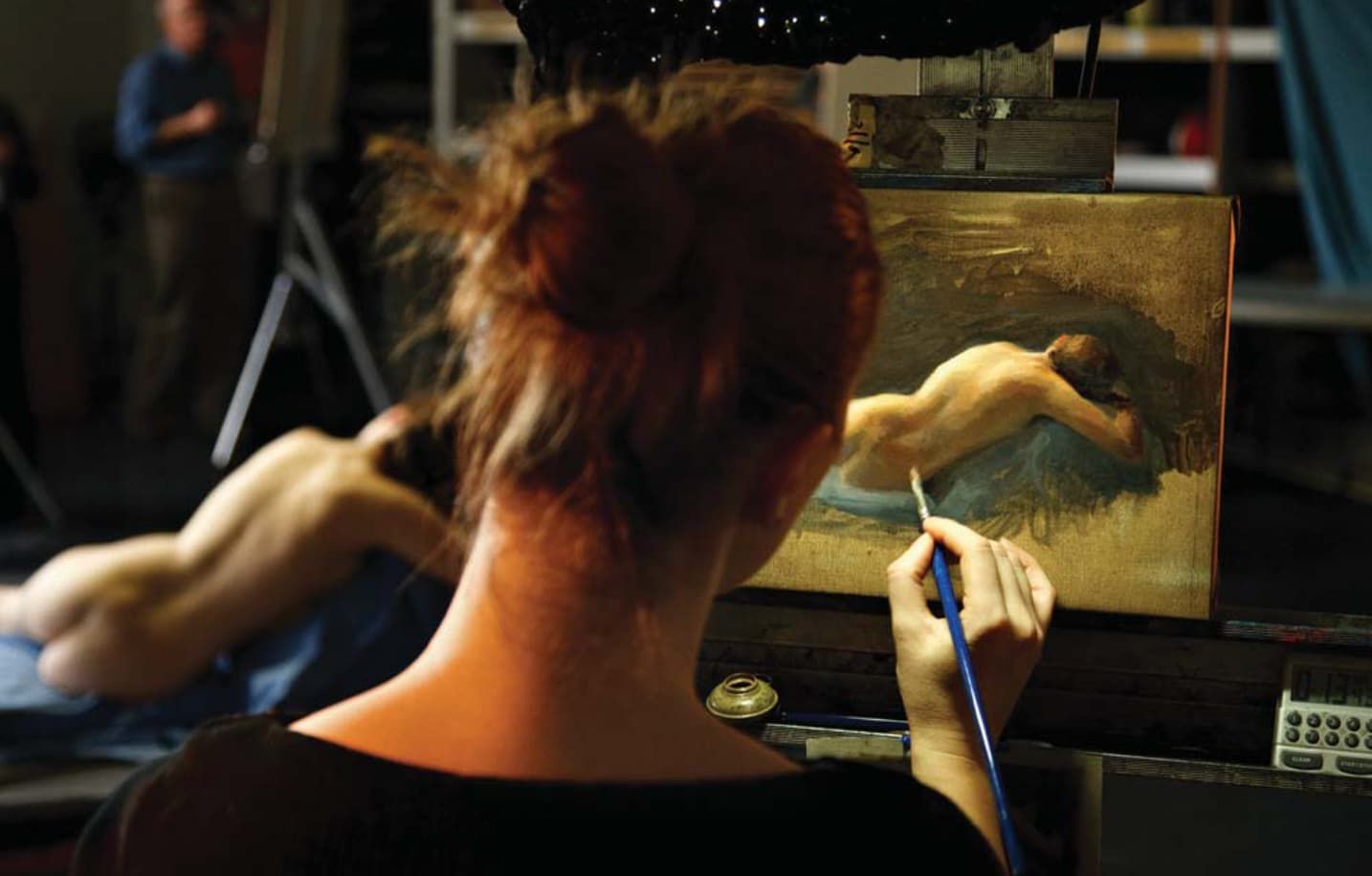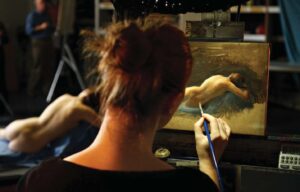
Methods for Accurate Drawing

The Sight-Size Drawing Method
Simply put, the sight-size method is the practice of painting or drawing at the same scale your eye sees your subject. When you look at your subject and drawing, they should be identical in size. Often artists practice the sight-size method by placing their surface directly next to the subject and drawing the subject life-size. (However, sight-size drawings need not be life-size.) If the artist positions the easel between him- or herself and the subject, the depiction of the subject will be correspondingly smaller on the drawing or painting surface. Famous artists throughout history, including such virtuosos as the Scottish painter Henry Raeburn and the American painter John Singer Sargent, used the sight-size drawing method.
Subject and Surface
Let’s examine a typical sight-size configuration that of placing your easel next to your subject. Ideally, you want the same light illuminating your subject and surface. Your surface should be as vertically upright on your easel as possible, forming a flat plane that sits alongside your subject. Next, determine your standing or viewing position. This should be about three times as far away from your subject as the subject is high. For example, if you’re drawing a 12-inch plaster cast, you could stand back about three feet. But this isn’t a hard-and-fast rule.
Basically, you want to be able to see your entire subject and draw at the same time without turning your head. You would mark the placement of your feet with tape. In fact, it’s also important to mark the positions of your subject and easel so you can configure everything exactly the same way during each drawing or painting session. Better yet, leave the whole setup untouched until you’ve finished your picture.
A Flick of the Eye
Using this configuration, you stand back to view your subject and walk to your surface to draw or paint. Use a plumb line (holding it horizontally) to plot the placement of the top and bottom of your drawing in relation to the subject. Lock in the overall measurements and placement of the subject. You then go on to find other measurements and angles directly from the subject. Sight size is a strictly observational drawing method; it progresses by flicking your eye between your subject and the drawing. If you’ve ever hunted for the differences between two side-by-side images, you understand the process of correction that occurs as you can quickly between your subject and your drawing to see what is not alike.
This drawing method can seem a little cumbersome the first time you try it but, over time, it becomes natural.
The Comparative Drawing Method
Comparative drawings can be any size, regardless of how far your surface is from the subject. Your subject could be a milk jug, and you could draw it the size of a person. Or it could be a full figure drawn to the size of your hand. In either case, a comparative drawing isn’t dependent on a one-to-one scale between your drawing and your subject, as seen by your eye.
In other words, the measurements aren’t cited directly from the subject onto the paper; rather, the drawing recreates a believable set of relationships that mirror the subject. You create your drawing by a set of comparisons, such as units of measurement generated from within the subject. For example, if your seated model measures three heads high, the proportion in your drawing would be the same. Or, if using a plumb line, the side of the head is directly over the inside of the ankle, your drawing would have the same alignment.
From the Inside Out
This drawing method is sometimes called “working from the inside out” because contour is often found later in the process. The artist tries to convey the essential aspects of the pose. Finding movement through a strong design is as important in this drawing style as fidelity to nature. Structural drawing is concerned with the internal building blocks of a subject. This includes landmarks created by bone structure, other anatomical considerations, large volumes, and aspects of design, such as directional lines.
In this approach, the artist generally stands or sits directly behind the easel; and the easel is at a slight angle to the subject. This allows the artist to turn his or her head, looking from paper to subject, which can be moved at will; since the artist is focusing on design, gesture, and volume, small shifts in the contour of the pose will not necessarily undermine anything essential.
When drawing comparatively, you want to be thoughtful about the accurate placement of your lines. Straight rods or skewers are common tools for siting and double-checking angles and measurements. A plumb line is good for checking the alignment of the top and bottom parts of the drawing.
Reconstructing Reality
A certain understanding of anatomy often comes into play, allowing artists to inform what they see with what they know. Knowledge of bone structure helps the artist locate skeletal landmarks. A knowledge of musculature can help the artist choose what to emphasize or downplay to convey the dynamic of a pose. Most figures or faces are soft and ill-defined. So, without some grasp of anatomy, understanding what you’re looking at can be difficult.
Think of the comparative drawing method as a recipe containing many ingredients, from playful directional lines and gestures to anatomy and measured proportions. Artists generally look for gestures to find the attitude of the pose in its essence. They’re less concerned with contour, as opposed to structural lines that are used to create a sense of verisimilitude. There is a reconstruction of reality rather than a one-to-one relationship with the subject.
Transcription vs. Translation
What are the respective advantages and disadvantages of the sight-size and the comparative methods of drawing?
There are advantages to both drawing methods, as well as points of overlap. The sight-size method is more of transcription while the comparative method is a translation. Each method has its unique identifying stylistic markers. Yet, both often start with some sort of block-in to generally place the subject on the page.
Sight-size has a wonderful naturalism. The resulting images can be painterly with an emphasis on large planes of light and broad shapes of value. A flow of light conveying an uncanny realism and a focus on the big effect indicate that the artist saw the subject wholly and from a distance. The disadvantage of this drawing method is that the artist is locked tightly into a fixed position. He or she is completely dependent on a direct transcription of nature with no intentional distortion, emphasis, or interpretation.
Comparative drawing can have energy a structural, planar quality that’s three-dimensional in its construction. Form drawing is often based nearly as much on an intellectual understanding of the subject as it is on direct observation from life, making it a unique record of an artist’s opinion. The artist must have a sophisticated understanding of the mechanics of drawing to achieve naturalism; otherwise, proportions can easily become distorted and the style contrived. The artist must also remember to stand back and take in the big effect, rather than locking into small areas of focus, resulting in a piecemeal approach. Keeping specific areas related to the drawing as a whole is important.
Both drawing methods have their practitioners, and each approach has been used to create outstanding drawings.
artistsnetwork.com


